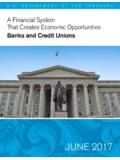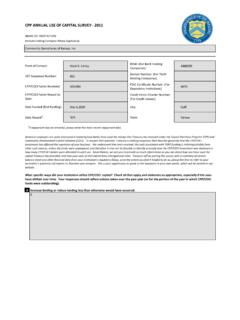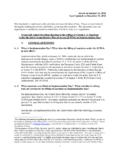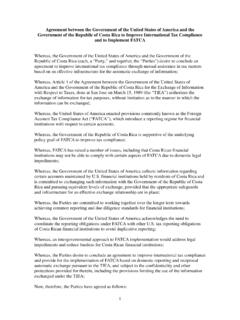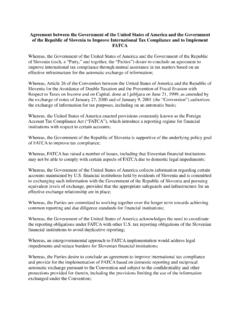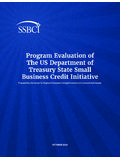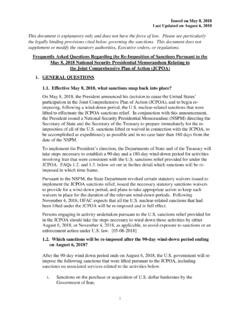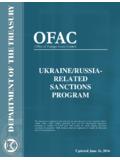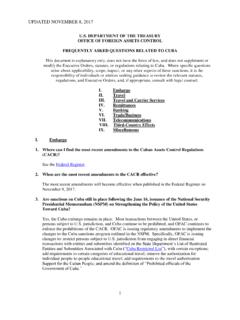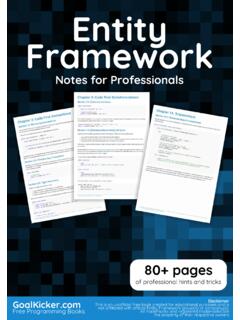Transcription of Getting Started Guide - U.S. Department of the Treasury
1 Getting Started Guide For Community Banks (Revised: March 16, 2011). Welcome to the Getting Started Guide for the Small Business Lending Fund. This guidebook is an overview designed specifically for community banks a term used here to include banks, thrifts, and bank and thrift holding companies with assets of less than $10 billion. This guidebook is divided into four chapters. Chapter One provides a general overview of Small Business Lending Fund benefits, eligibility, and terms. Chapter Two provides information relating to the application process. Chapter Small businesses are a vital part Three provides more detailed information about how the Small Business Lending Fund works specifically, what of the American economy. Their success qualifies as small business lending, how dividends are is a necessary component of the calculated, and how to address applicable reporting requirements. Chapter Four describes what happens after economic recovery.
2 Currently, many small an institution receives SBLF funding. businesses face challenges in accessing the credit they need. Enacted into law as part If you have questions at any point, please contact the information line for the Small Business Lending Fund at of the Small Business Jobs Act of 2010 888-832-1147 (Monday-Friday, 9:00 AM-7:00 PM ET). to increase small business lending, the Small Business Lending Fund is TABLE OF CONTENTS. designed to provide up to $30 billion in AT A GLANCE: capital to qualified community banks and The Small Business Lending Fund for Community Banks 1. other eligible financial institutions. CHAPTER ONE: The Small Business Lending Fund will help Introduction 2. create jobs and promote economic growth CHAPTER TWO: in local communities across the nation How to Apply to the Small Business while enabling Main Street banks to better Lending Fund 6. extend credit to their customers by utilizing CHAPTER THREE: the incentives that the Fund provides.
3 How the Small Business Lending Fund Works 11. CHAPTER FOUR: After Your Bank Receives Funding 17. (Revised: March 16, 2011). AT A GLANCE: THE SMALL BUSINESS LENDING FUND FOR COMMUNITY BANKS. Through the Small Business Lending Fund, the Department of the Treasury provides Tier-1 capital to Overview community banks and other eligible institutions. Each institution pays dividends at rates that go down as its small business lending goes up. Insured depository institutions with assets of less than $10 billion, not controlled by a holding company or an entity with assets of $10 billion or more (as of the end of the fourth quarter of calendar year 2009). Bank and savings and loan holding companies with consolidated assets of less than $10 billion Eligibility Treasury will publish separate terms for mutual institutions, Subchapter S corporations, and community development loan funds; this guidebook does not apply to those institutions Institutions currently or recently on the FDIC problem bank list (or similar list) are ineligible.
4 Senior perpetual noncumulative preferred stock (or equivalents) qualifying as Tier 1 capital Depository Up to 5% of risk-weighted assets (RWA) if assets are $1 billion or less institutions: Up to 3% of RWA if assets are more than $1 billion but less than $10 billion Up to 5% of RWA if consolidated assets of all depository institution subsidiaries are $1 billion or Amount of Holding less Funding companies: Up to 3% of RWA if consolidated assets of all depository institution subsidiaries are more than $1 billion but less than $10 billion Treasury may require matching private capital and limit SBLF funding to 3% of RWA even if assets are $1 billion or less. Qualified Small Business Lending for purposes of the Small Business Lending Fund is defined as follows: Qualified Small Business Lending includes all: so long as: 1. Commercial and industrial loans the original principal and commitment amount is Qualified 2. Loans secured by owner-occupied nonfarm, $10 million or less Small nonresidential real estate the loan is not to a business with more than $50 million Business 3.
5 Loans to finance agricultural production and in revenues Lending other loans to farmers and excluding loan portions guaranteed by the 4. Loans secured by farmland Government or for which a third party assumes risk. An institution that receives capital from the Small Business Lending Fund will supplement its Call Report with a Supplemental Report that identifies Qualified Small Business Lending. Lending Increase Dividend Rate Dividend rates upon funding and for the Less than 5%. following nine calendar quarters, adjusted or more, but less than 5% 4%. quarterly (based on outstanding loans at the 5% or more, but less than 3%. end of the second previous quarter): or more, but less than 10% 2%. Dividend 10% or more 1%. Rates If lending has increased at the end of the Rate set as above for Dividend rate for the tenth quarter after eighth quarter after funding the tenth quarter funding through the end of the first four and one-half years: If lending has not increased at the end of 7%.
6 The eighth quarter after funding Dividend rate after four and one-half years 9%. (if funding has not already been repaid): Given application processing times, applications should be submitted to Treasury by March 31, 2011. Entry and Provide a small business lending plan, approximately two pages in length, to the institution's regulator (not Exit directly to Treasury ). Repay SBLF funding at any time with regulatory approval. For general inquiries and questions, please call the Small Business Lending Fund information line at 888-832-1147. More Info For communications pertaining to a specific institution, please email a confidential email address. (Revised: March 16, 2011) 1. CHAPTER ONE: INTRODUCTION The more a bank increases its small business lending, the lower the rate it will pay for the SBLF funding. Through the Small This chapter provides an overview of the Small Business Business Lending Fund, community banks and small Lending Fund, which is administered by the businesses can work together to create jobs and promote Department of the Treasury .
7 The chapter is designed to local economic growth in neighborhoods across the nation. provide answers to general questions your institution might have about the Small Business Lending Fund, including: Many loans made by community banks will qualify as small business lending under the Jobs Act. The law defines What is the Small Business Lending Fund? small business lending to include loans of up to $10 million to businesses with up to $50 million in annual revenue. Which institutions does this guidebook address? Those loans include: How can the Small Business Lending Fund help my Commercial and industrial loans institution? Loans secured by owner-occupied nonfarm, nonresidential real estate Is my institution eligible to apply to participate in the Loans to finance agricultural production and other Small Business Lending Fund? loans to farmers Loans secured by farmland How much funding can my institution receive? If my institution's Small Business Lending Fund Which institutions does this guidebook address?
8 Application is approved, is it obligated to participate? This material applies to community banks and community development loan funds that have total assets of less than After receiving capital, can my institution exit the Small $10 billion. Business Lending Fund at any time? For purposes of this guidebook, the terms community How is small business lending defined for purposes of bank and bank encompass banks, thrifts, and bank and the Small Business Lending Fund? thrift holding companies with consolidated assets of less than $10 billion. How is the Small Business Lending Fund dividend rate calculated? This guidebook does not apply to mutual institutions, Subchapter S Corporations, or community development What kind of reporting is required? loan funds. Can my institution continue paying dividends and repurchasing stock if it receives SBLF funding? How can the Small Business Lending Fund help my institution? Can my institution refinance outstanding CPP or CDCI.
9 Securities through the Small Business Lending Fund? The Small Business Lending Fund aims to stimulate small business lending by reducing the dividend rate paid by a Is the Small Business Lending Fund related to the community bank on SBLF funding as the bank increases its Troubled Asset Relief Program (TARP)? lending. The cost of capital provided through the Small Business What is the Small Business Lending Fund? Lending Fund will start no higher than 5%. If your community bank's small business lending increases by 10%. Enacted into law as part of the Small Business Jobs Act of 2010. or more, then the rate will fall to as low as 1%. For (the Jobs Act), the Small Business Lending Fund encourages increases in small business lending that are less than 10%, the lending to small businesses by providing capital to community rate can fall to between 2% and 4%. banks with under $10 billion in assets. Treasury will make SBLF funding available by purchasing senior preferred stock or equivalents in institutions that (Revised: March 16, 2011) 2.
10 Apply and are approved for participation in the Fund. SBLF Treasury will publish separate terms for mutual institutions, funding will be Tier-1 capital. Subchapter S corporations, and community development loan funds (CDLFs). Terms for such institutions may vary Participation in the Small Business Lending Fund is entirely from those described in this guidebook. voluntary. Banks may repay their SBLF funding at any time with regulatory approval. An institution is not eligible if it is on the FDIC's problem bank list (or similar list) or has been removed from that list Access to capital through the Small Business Lending Fund in the previous 90 days. can boost your institution's lending capacity while helping to create jobs and promote economic growth in local The Small Business Lending Fund also provides an option for communities across the nation. community banks to refinance preferred stock issued to Treasury through the Capital Purchase Program (CPP) or the The Small Business Lending Fund: Community Development Capital Initiative (CDCI) under certain conditions.
